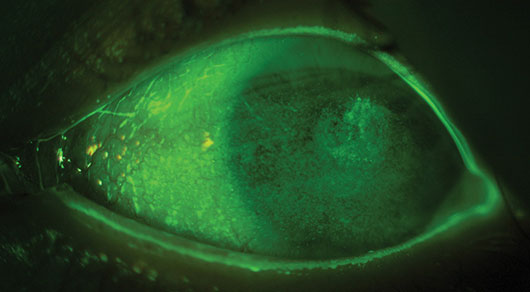Dry Eye
Dry eye syndrome (Keratoconjunctivitis sicca) is a surprisingly common condition that happens when there is a problem or imbalance in the composition of the eye’s tears.
When we blink we spread a special layer of tears, called the tear film, over the surface of the eye. The tear film is made of three layers, a bit like a sandwich; an oily (lipid) layer on the outside, a watery (aqueous) layer in the middle and a mucin (a glycoprotein) layer on the inner most side. The tear film is there to help keep the eye clean, healthy and it plays a large part in seeing clearly too.
As a result of any imbalance the tears in the eye often evaporate too quick or are just simply not produced by the eyes in the needed quantity and/or quality.
In some cases dry eye can be caused by conditions such as blepharitis (an inflammation of the lid margins), demodex (a mite infestation) or meibomian gland dysfunction (the oil producing ducts become blocked). There are of course many other reasons the tear film becomes compromised including medical conditions such as Sjögren’s syndrome or arthritis, environmental factors such as heating or air conditioning and other factors such ageing or occupation.
People with improperly managed or unmanaged dry eye syndrome are more at risk of developing infections such as conjunctivitis, eyelid cysts, styes or sight threatening complications such as corneal ulcers and scars.
However, if properly treated the symptoms of dry eye can be alleviated and most risk factors eliminated or reduced.
Due to the complexity of the tear film, proper management of the dry eye requires a thorough assessment before treatment begins. This assessment allows us to actually target the root cause(s) rather than merely trying assorted drops to manage the symptoms, many of which may not work for the specific dry eye.
How is this assessed?
During the dry eye assessment your specialist optometrist will discuss your symptoms and using specialist testing establish if you actually have dry eye & what type you have. Having carefully discussed all the findings with you they will make a recommendation of the best course of treatment. The assessment is performed at a separate appointment to an eye examination as many of the tests we perform at the eye examination will interfere with the analysis of the tear film.
By approaching dry eye with specialist equipment and a bespoke, targeted manner based on your individual eyes and your specific symptoms we may be able to help you even if to no avail you have tried drops from the GP or have used over the counter drops form your pharmacist before.
We receive referrals from GP’s and opticians whose patients have tried numerous treatments without success.
If you think you suffer from Allergic eye disease book in today to the DF Optometrists’ therapeutic clinic for the targeted, effective relief.
Dry Eye Summary
Dry eye syndrome (Keratoconjunctivitis sicca) is a surprisingly common condition that happens when there is a problem or imbalance in the composition of the eye’s tears.
When we blink we spread a special layer of tears, called the tear film, over the surface of the eye. The tear film is made of three layers, a bit like a sandwich; an oily (lipid) layer on the outside, a watery (aqueous) layer in the middle and a mucin (a glycoprotein) layer on the inner most side. The tear film is there to help keep the eye clean, healthy and it plays a large part in seeing clearly too.
As a result of anything that causes an imbalance in tears causes a form of dry eye.
Symptoms include:
- feelings of dryness, grittiness or soreness that vary across the day
- watery eyes
- sticky eyelids, especially upon waking
- blurred vision that gets better on blinking
- red eyes
- light sensitivity
Due to the complexity of the tear film, proper management of the dry eye requires a thorough assessment before treatment begins. This assessment allows us to actually target the root cause(s) rather than merely trying assorted drops to manage the symptoms, many of which may not work for the specific dry eye.
Treatment can include
- Drops
- Ointment
- Gel
- Hot Compress
- Eyelid Hygeine
- BlephEx treatment
- Punctum Plugs







